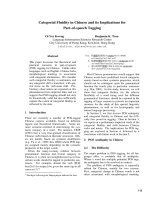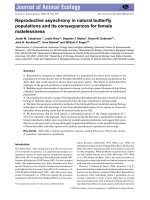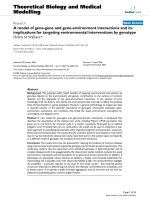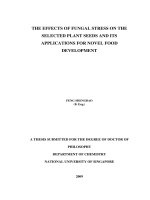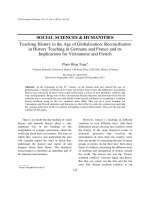Report on the Under-Treatment of Pain in Victims Injured in the 2008 Wenchuan Earthquake and its Implications for Future Emergencies
Bạn đang xem bản rút gọn của tài liệu. Xem và tải ngay bản đầy đủ của tài liệu tại đây (201.62 KB, 23 trang )
Report on the Under-Treatment of Pain in Victims Injured in the 2008 Wenchuan
Earthquake and its Implications for Future Emergencies
Short Title: Untreated Pain Following the Wenchuan Earthquake
Hong Xiao, MD1, Yun-Xia Zuo, MD, PhD2, Bang-Xiang Yang, MD3,Li Song , MD4,
Chuan-Bing Wen, MD5,Yue-E Dai, MD6, Hui YU, MD7, Li-Li Xu, MD8, Qiao Guo, MD9,
Zhi-Ping Song, MD10, Ernest Volinn, PhD11, Jin Liu, MD12, and Hui Liu, MD13
1. Associate Professor, Department of Anesthesiology, West China Hospital, Sichuan
University, Chengdu, Sichuan 610041, China.
2. Professor and Vice-Chairman of Department of Anesthesiology, West China
Hospital, Sichuan University, Chengdu, Sichuan 610041, China.
3. Attending Physician, Department of Anesthesiology, West China Hospital, Sichuan
University, Chengdu, Sichuan 610041, China.
4. Attending Physician, Department of Anesthesiology, West China Hospital, Sichuan
University, Chengdu, Sichuan 610041, China.
5. Anesthesia Resident, Attending Physician, Department of Anesthesiology, West
China Hospital, Sichuan University, Chengdu, Sichuan 610041, China.
6. Anesthesia Resident, Attending Physician, Department of Anesthesiology, West
China Hospital, Sichuan University, Chengdu, Sichuan 610041, China.
7. Anesthesia Resident, Attending Physician, Department of Anesthesiology, West
China Hospital, Sichuan University, Chengdu, Sichuan 610041, China.
8. Anesthesia Resident, Attending Physician, Department of Anesthesiology, West
China Hospital, Sichuan University, Chengdu, Sichuan 610041, China.
9. Anesthesia Resident, Attending Physician, Department of Anesthesiology, West
China Hospital, Sichuan University, Chengdu, Sichuan 610041, China.
10. Anesthesia Resident, Attending Physician, Department of Anesthesiology, West
China Hospital, Sichuan University, Chengdu, Sichuan 610041, China.
11. Research Associate Professor, Pain Research Center, School of Medicine,
Department of Anesthesiology, University of Utah
Corresponding authors:
Hui Liu, MD
Professor, Department of Anesthesiology
West China Hospital
Sichuan University
Chengdu, Sichuan 610041, China
Email:
Jin Liu, MD
Professor and Chairman, Department of Anesthesiology
West China Hospital
Sichuan University
Chengdu, Sichuan 610041, P.R. China,
Tel:+86-02885423591
Fax: +86-28-85423591
Email:
This work was supported by grant No. 30872435 from the National Research
Foundation of Nature Science, Beijing, China.
The authors declare no conflicts of interest.
ABSTRACT
Background: On May 12, 2008, an earthquake measuring 8.0 on the Richter scale
occurred in Wenchuan County, Sichuan Province, China. Shortly afterwards, we
interviewed some of the victims to investigate the physical pain they had suffered. Our
aim was to catalogue the physical pain associated with disasters of this magnitude and
to provide an initial assessment of the general adequacy of treatment for pain.
Methods: We collected our data about five weeks after the earthquake. Data on pain
were collected from 848 victims, in ten different hospitals, and in shelter tents set up for
the earthquake refugees in seven different towns near the epicenter of the earthquake.
Trained interviewers, speaking in the local dialect, conducted face-to-face interviews
with these victims.
Results: The mean pain intensity was 6.6 ± 0.5, with the most intense being at the time
of surgical debridement (VAS score 7.2 ± 2.1), and the lowest being before surgery in
the wards (VAS score 6.1 ± 2.1). Victims with open bone fractures had more severe
pain intensity than the other three types of injuries (VAS score 6.9±1.3). Very few victims
received pain treatment (2.5% at the scene of injury, 1.6% at the time of rescue, 2.9%
during debridement, 3.9% when transferred to the hospital, 19% in the hospital
emergency department, 25% preoperatively in the surgical ward and 50%
postoperatively). Only 60% of the patients who received postoperative analgesia were
satisfied with their pain management. Pain ratings did not vary according to gender,
occupation, educational status, or hospital where treated. Pain ratings were higher for
patients older than 60 years than for younger patients.
Conclusions: The pain suffered by most of the victims was under-estimated and under-
treated. The high degree of pain in major disasters highlights the need for emergency
preparedness, including local training on pain relief procedures, and the necessity for
expeditious transport of pain relief supplies. Emergency services, including both field
and hospital medical teams, should be supplemented by professional pain physicians
and a standard pain control regimen adopted for major disasters.
INTRODUCTION
On May 12th, an earthquake measuring 8.0 on the Richter scale struck Wenchuan
County, Sichuan Province, China. It resulted in the deaths of 69,197 people, 374,176
injuries, and 18,222 missing individuals. An estimated 4.8 million people lost their
homes and became shelter refugees (1). Rescue operations and the emergency aid to
the injured were obviously critical in a disaster of this magnitude (2-4). Prompt effective
pain treatment, although also essential for the patients' physical and mental recovery (57), may have been lacking (8). Aside from acute pain experienced at the time of the
disaster, under-treated pain may lead to lasting symptoms and debility, including chronic
pain and posttraumatic stress disorder (PTSD) (9-13).
For these reasons, in the immediate aftermath of the Wenchuan earthquake, we
assembled a trained team in order to address the following questions:
1. To what extent did injured patients experience physical pain?
2. Did they receive analgesia commensurate with their pain?
3. Among those injured, did demographic characteristics account for variations in
the intensity of pain experienced?
4. More generally, what is the role of pain physicians in rescue operations?
METHODS
Study design and data collection
West China Hospital, an affiliate of Sichuan University, and local medical research
ethics committees approved the study. This was a retrospective investigation. Data were
collected for the study, which began about five weeks after the earthquake. The study
took place between June 22-September 7, 2008. Trained interviewers, speaking in the
local dialect, conducted face-to-face interviews.
Interview Schedule
The interview contained the three parts: 1) basic demographic variables (gender, age,
address, educational level, and occupation), diagnosis of injuries, and hospital name; 2)
Pain intensity (0 to 10 Visual Analogue Scale), and 3) the corresponding pain treatment
and its effect.
Samples
Patients were recruited from the following three locations: the local hospital, the
rehabilitation hospital, and the shelter tents for the earthquake refugees. While injured
patients were in the hospital or shelter tents, interviewers approached physicians and
collected data on patients’ diagnoses and pain treatment. Patients were included if they
were injured in the earthquake and consented to the interview. Patients were excluded if
they were unable to communicate in Mandarin or the local dialect, or were too disabled
to communicate. Patients were initially asked to respond to part 1 of the interview.
Patients were assessed using parts 2 and 3 at seven points in time:
1. the scene of the injury,
2. when rescued,
3. during surgical debridement,
4. on transfer to the hospital,
5. in the hospital emergency department,
6. in the ward waiting for an operation, and
7. during the postoperative period.
Instrument and key measures
The intensity of pain was measured by ratings using 100 mm visual analogue scales
(VAS), whose endpoints were anchored by 0 (no pain) and 100 (cannot endure).
Respondents were asked to place a mark along the scale to indicate their actual level of
pain (“How intense was your pain?”). The effect of the analgesia was divided into five
grades, anchored by grade 1 (excellent analgesic effect) and grade 5 (no analgesic
effect). Earthquake injuries were summarized as fitting into four categories: soft tissue
injury, closed bone fracture, open bone fracture, and multiple injuries. The term ”multiple
injuries”’ refers to a single cause leading to the injury of two or more organs.
RESULTS
Demographic characteristics of the earthquake victims
Eight hundred forty-eighty earthquake victims from seven towns near the epicenter of
the earthquake were interviewed. Their median age was 48 years. Fifty-nine percent
were 18-60 years old. The range in ages was 7 years to 102 years. Patients were
evenly divided among males (49%) and females (51%). Their occupations consisted of
farmers (47%), students (13%), workers (9%), soldiers (1.3%) and others (9%). Thirteen
percent were unemployed. Seven percent had a university education, 15% and 26%
had completed senior and junior school, respectively, and the other 52% had received
less than a junior school education. These earthquake victims suffered mainly from soft
tissue injuries (20%), closed bone fractures (56%), open bone fractures (19%), and
multiple injuries (4.6%).
Pain intensity (VAS score) among the earthquake victims
The pain intensity (VAS score) suffered by the 848 earthquake victims from the initial
injury to the postoperative time was assessed by face-to- face interviews. The mean
pain intensity was 66 ± 5 mm. The highest VAS score at the time of surgical
debridement in the field emergency aid areas was 72 ± 21 mm. The lowest VAS score
was 61 ± 21 mm, which was recorded in the surgical ward at the time of waiting for the
operation. The trend of pain intensity changes is shown in Figure 1.
Pain intensity was also analyzed according to the type of injury. Victims with open bone
fractures recorded a higher intensity of pain (VAS score 69 ± 13 mm) than those in the
other three categories. For soft tissue injuries, the mean pain intensity was 60 ± 12 mm.
Soft tissue injuries also had the highest pain intensity in the field at the time of surgical
debridement (VAS score: 66 ± 21 mm).
Although the patients reported less pain while waiting for surgery, it was still 55 ± 20
mm. For closed bone fracture injuries the mean pain intensity was 68 ± 15 mm.The
highest pain intensity was recorded at the scene of the injury, 73 ± 24 mm, and the
lowest VAS score was immediately prior to surgery, 60 ± 20 mm. For open bone
fractures the mean VAS score was 69 ± 13 mm, with the highest pain intensity recorded
in the field at the time of surgical debridement, 77 ± 19 mm. During the postoperative
period, the VAS score was 62 ± 24 m. For multiple injuries, the mean VAS score was 63
± 13 mm, while the highest score, recorded at the time of transfer to the hospital, was
67 ± 25 mm. The lowest pain score, 58 ± 23 mm, occurred during the postoperative
period.
Differences in VAS score were found among the various ages of patients. Patients over
60 years old appeared to have higher pain intensity in all injury categories than the
younger victims. No significant differences in VAS scores were found in relation to
gender, occupation, or educational status. Loss family members or relatives from the
earthquake did not influence pain intensity. Pain intensities of those who were sent to
small local hospitals did not differ from those who were sent to the tertiary hospitals,
regardless of the different pain treatments they received.
Pain treatment and its effect on the earthquake victims
Only 2.5% of the earthquake survivors received pain treatment (Table 1) at the time of
injury. Similarly, 1.6% received pain treatment when rescued, 2.9% at the time of
surgical debridement, and 3.9% when transferred to the hospital. After the victims were
transferred to the hospital, their pain was also under-treated. The percentage of victims
who had pain treatment was only 19% when they were in the emergency departments
of hospitals and 25% during the preoperative time in the surgical wards. Only half of
those who went to surgery received postoperative analgesia.
The primary analgesia for those who received anything was oral or intramuscular
injection (Table 1). Tramadol and meperidine were the most commonly used
medications. In the hospital emergency departments, of the 18.9% of victims who
received pain treatment, 38% were given tramadol, while 9% were given meperidine. Of
the 25% of patients who received pain treatment prior to surgery, 37% were treated with
tramadol and 10% with meperidine. For postoperative analgesia, the most commonly
used prescription was also tramadol (27% of the patients) and meperidine (28% of
patients). Patient-controlled analgesia was used in only 23% of the patients who
received postoperative analgesia. Nonsteroidal antiinflammatory drugs and morphine
were also occasionally used for postoperative analgesic treatment. Table 2 summarizes
the analgesics used.
Analgesia was not particularly effective in the few who did receive pain treatment. We
divided the analgesia effects into five grades as described in the Methods. As shown in
Table 3 and Figure 2, half of the patients reported the analgesic effect as grade 4 or 5
(i.e. little effect or no effect) at the time of rescue. In addition, of those who received pain
treatment at the time of transfer to the hospital, 30% reported the analgesic effect as
grade 4 or 5. Of those receiving postoperatively analgesia, 60% reported the analgesic
effect as grade 1 or grade 2. The analgesic effects of those who were sent to small local
hospitals did not differ from those who were sent to the higher tertiary hospitals,
regardless of the different pain treatments they received.
DISCUSSION
The World Health Organization defines natural disaster as an ecological phenomenon of
a sufficient magnitude to require external assistance (14). Disasters are inevitable and,
as profound as its deleterious effects may have been, the Wenchuan earthquake did
afford the opportunity to become better prepared for future disasters (15-18). In our
investigation, the main findings were: 1. Survivors frequently experienced moderate to
severe pain from the time of the initial injury up to the end of the relief work after the
earthquake. 2. Pain was under-recognized and under-treated throughout the entire
period from the field rescue to the hospital treatment. 3. Survivors with open bone
fractures had the most severe pain. 4. No significant differences in visual analog scale
(VAS) scores were found in relation to gender, occupation, educational status, or
hospital. However, patients over 60 years old appeared to have more severe pain than
younger patients for all categories of injuries, and bone fractions were more painful than
the other types of injuries.
When a disaster occurs, saving lives is the overriding priority (19). However, this may be
done at the expense of other needs, such as alleviating suffering (20,21). Pain is a
conspicuous aspect of the suffering, even though it may be neglected in emergency
situations. The presumption may be that victims will ignore the pain, since all their
attention is focused on staying alive, and on the injury itself (22). Nevertheless,
according to our findings, earthquake survivors experienced severe pain from their
injuries unmitigated by fear of loss of life.
Since many of the victims we interviewed did not receive any pain treatment, we are
able to view the natural course of pain caused by this earthquake disaster. The trend of
the changes in the intensity of pain was shown in Figure 1. The highest VAS score was
at the time of surgical debridement in the field emergency aid areas. The lowest VAS
score was while waiting for surgery. It was astonishing to see how the pain was
neglected at the time of surgical debridement in the field emergency aid areas. This
indicated that the members of our first aid medical team focused their attention on the
victims’ injury, but neglected treatment of pain.
The poor treatment of pain offered by the medical workers in the field may be due to the
limitation of analgesic resources, though victims would expect to have better pain
treatment in the hospital. However, the pain of the survivors was also under-recognized
and under-treated in the hospital. A lack of awareness of the importance of pain control
may have been coupled with an exaggerated fear of analgesic side effects.
Treatment of pain has been shown to be neglected in other disasters such as
hurricanes (23). Therefore, more attention must be paid to pain management, and to the
application of appropriate pain treatment at every stage from the initial field rescue to
the hospital treatment, with particular emphasis on the field rescue stage. It is strongly
recommended that pain physicians be included in all future emergency relief teams to
facilitate the immediate relief of the pain suffered by victims. In our view, a team of
professional pain treatment personnel should be formed and a standard pain control
regimen established to better address future situations of this kind.
FIGURE LEGENDS
Figure 1. The pain intensity (visual analog scale score) of the patients throughout the
entire relief work
Timepoint 1= At the scene of the injury, 2= Being rescued, 3= Being debrided, 4= Being
transferred, 5=The time patients were in the hospital emergency department,
6= Preoperative time, 7= Postoperative time.
Figure 2. The analgesic effect of the investigated patients who received pain treatment
Injury= At the scene of the injury, Rescued= at the time of being rescued, Debride= at
the time of being debrided, Transferred=when being transferred, Emergency=The time
of patients be in hospital Emergency, Preoperative= Preoperative time, Postoperative=
Postoperative time.
ACKNOWLEDGMENT
We are indebted to Professor Cheng-Qi He (Department of Rehabilitation, West China
Hospital, Sichuan University) for assistance with the investigation, to Dr. Zhao-Yang Hu
(Department of Anesthesiology, West China Hospital, Sichuan University) for assistance
with the preparation of the manuscript, and to Howard Stones for comments on the
manuscript.
REFERENCES
1. September 22, 2008
18:18 CST.
2. Raissi GR, Mokhtari A, Mansouri K. Reports from spinal cord injury patients: eight
months after the 2003 earthquake in Bam, Iran. American Journal of Physical Medicine
& Rehabilitation. 2007;86:912-7.
3. Wattanawaitunechai C PP, Jitpratoom P. Tsunami in Thailand — Disaster
Management in a District Hospital. N Engl J Med 2005;352:962-4.
4. Schnitzer BS. Earthquake Relief — The U.S. Medical Response in Bam, Iran. N Engl
J Med 2004;350:1174-6.
5. Harris KC, Rathmell JP. Forward-deployed anesthesiologists and pain treatment in
combat support hospitals: making decisions about deployment of anesthesiologists in
support of the global war on terrorism. Anesthesiology 2007;107:872-4.
6. Livanou M, Kasvikis Y, Başoğlu M, Mytskidou P, Sotiropoulou V, Spanea E,
Mitsopoulou T, Voutsa N. Earthquake-related psychological distress and associated
factors 4 years after the Parnitha earthquake in Greece. . European Psychiatry: the
Journal of the Association of European Psychiatrists 2005;20:137-44.
7. Nufer KE, Wilson-Ramirez G, Shah MB, Hughes CE, Crandall CS. Analysis of
patients treated during four Disaster Medical Assistance Team deployments. Journal of
Emergency Medicine 2006;30:183-7
8. Moszynski P. Pain control often neglected in war areas. BMJ 2004;328:1398.
9. Geisser ME, Roth RS, Bachman JE, Eckert TA. The relationship between symptoms
of post-traumatic stress disorder and pain, affective disturbance and disability among
patients with accident and non-accident related pain. Pain 1996;66:207-14
10. Norman SB, Stein MB, Dimsdale JE, Hoyt DB. Pain in the aftermath of trauma is a
risk factor for post-traumatic stress disorder. Psychological Medicine 2008;38(4):533-42.
11. Asmundson GJ, Coons MJ, Taylor S, Katz J. PTSD and the experience of pain:
research and clinical implications of shared vulnerability and mutual maintenance
models. Canadian Journal of Psychiatry - Revue Canadienne de Psychiatrie.
2002;47:930-7.
12. Asmundson GJ, Wright KD, Stein MB. Pain and PTSD symptoms in female
veterans. European Journal of Pain 2004;8(4):345-50.
13. Yehuda R. Post -Traumatic Stress Disorder. N Engl J Med 2002;346:108-14.
14. Organization: PAH. Emergency Health Management After Natural Disaster.
Washington, DC, Emergency Preparedness and Disaster Relief Coordination
Unit, 1981.
15. Logue JN. Disasters, the environment, and public health: improving our response.
American Journal of Public Health. 1996;86:1207-10.
16. Friedman E. Coping with calamity. How well does health care disaster planning
work? JAMA 1994;272(23):1875-9.
17. Muller JE, Verrier RL. Triggering of sudden death--lessons from an earthquake. New
England Journal of Medicine 1996;334:460-1.
18. Lagerkvist B. Rehabilitation research under fire. Scandinavian Journal of Social
Medicine 1998;26:85-6.
19. Gosselin RA. War Injuries, Trauma, and Disaster Relief. Techniques in
Orthopaedics. Orthopaedic Surgery in the Developing World. 2005:97-108.
20. Newman M BD, Hendriks J H. Victims of disaster, War, Violence, or
Homicide:Psychological Effects on Siblings. Child and adolescent Mental Health
2007;2:140-9.
21. Klinteberg R. Management of disaster victims and rehabilitation of uprooted
communities. Disaster 2007;3:61-70.
22. Kessler RC PR, Wortman CB. Social Factors in Psychopathology:Stress, Social
Support, and Coping Processes. Annual Review of Psychology 1985;36:531-72.
23. Relief Physician Says Pain Control During Disaster Should Be Food for
Thought, Possibly Included in Training. Topics in Pain Management. 2005;21:8-9.
Table 2: Main pain relievers used throughout the relief effort.
Table 3: Analgesic efficacy
Figure 1
Figure 2
